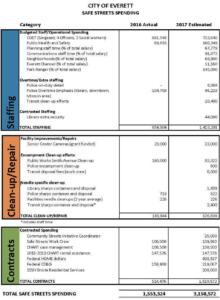Editor’s Note: We’ve been covering the Safe Streets Initiative since its inception a couple of years ago. As part of that coverage we want to present to you the discussion of costs about the project. Usually our articles are shorter with links to relevant documents but given the complexity of the subject we wanted to present this in a fuller context. We hope this helps our readers get a better understanding of how Everett is dealing with such a complex problem. LD

This is a breakdown of the costs between 2016 and 2017 presented to city council members Wednesday. Click to enlarge.
Recently Scott Murphy, chair of the Everett City Council’s budget committee asked the City of Administration for a breakdown of spending on the Streets Initiative.
That’s not such an easy question for city staff to answer as it depends on what departments normally spend on their tasks and then what is broken out to Safe Streets projects.
On Wednesday, the budget committee heard from Hil Kaman, Public Health and Safety Director for the City of Everett.
Kaman explained that there were a variety of factors in trying to calculate just how much money is being spent. He presented the following overview to try and clarify questions posed by council members.
Safe Streets Update
Council Budget Committee Meeting, September 13, 2017
- Overview of the Safe Streets Spending
- Many departments allocate resources to address street level social issues even if not directly involved in Safe Streets Programs.
- Spending is a mix of public safety, human needs, and facilities/clean-up efforts.
- Full impact not captured only by looking at specific allocated funds since many departments address issues in course of business.
- Broad Spending Categories
- Staffing
- Full time dedicated staff and staff who work partly on Safe Streets.
- Staff time addressing issues as part of regular course of work.
- Facility improvements, vandalism repair, and clean-up efforts.
- Contracted services for public safety, housing, and human services.
- Streets Initiative, Work Crew
- Human Needs grants
- Staffing
- Housing dollars (mostly pass through Federal dollars)
- Costs not yet quantified
- Staff time inspecting damage and processing paperwork for repairs.
- Staff time responding to citizen inquiries.
- Percent of public safety dedicated to addressing these issues (Jail for example).
- Safe Streets Supportive Housing
- Scattered Site
- $422,729 HOME funds allocated to Tenant-based rental Assistance.
- $108,500 Human Needs allocated to Housing Case Management.
- Capital facility
- City contribution of land, valued approximately $360,000.
- $1 million from City using pass-through money awarded from Snohomish. County
- Scattered Site
- $2.5 million from State Housing Trust Fund (includes 950,000 for High Energy Efficiency Project Design).
- $11-13 million from 9% Low Income Housing Tax Credit program.
- $600,000 from 1/10 1% CD/MH tax dollars from County (part of the gap financing plan) .
- $100,000 grant from Rotary Club of Everett.
- $200,000 annual budged for ongoing services (County and Providence match).
- Other related expenses
- $400,000 reallocated from operations to Housing Hope through tax credit share.
To help further explain the spending as it relates specifically to low barrier housing projects planned for Everett here is an email Kaman sent to City of Everett CFO Debra Bryant who passed it along to the Everett City Council.
You will find below responses to your questions from last week, and I’m looking forward to discussing these issues in more detail at the Sept. 13 budget committee meeting. Should it be helpful, I have also included here some further background on the community-wide work over the past months that led to the requested $400,000 budget amendment.
The Community Streets Initiative task force process sparked a surge in affordable housing development in Snohomish County. Historically, the County has been undersubscribed to dollars from the State and through programs like the low-income housing tax-credit program. With so much momentum coming out of the CSI, we suddenly found ourselves with three important housing projects all moving forward on the same timeline: Catholic Housing Services (CHS)/City Safe Streets Supportive Housing Project for chronically homeless, Housing Hope HopeWorks Station II workforce housing, and the Cocoon House project for homeless young adults. This resulted in a funding bottleneck for local dollars, Housing Trust Fund Dollars and tax-credit allocations.
For months, staff from the City, the County, and the developers worked to resolve the funding challenges. As the negotiations developed, all of the Snohomish County affordable housing providers came to the table to help find a solution. The entire community convened around the goal of seeing each of these three projects come to fruition on the proposed timeline and of setting up a pipeline for developments so that we could avoid similar funding bottlenecks in the future. Building affordable housing is a competitive prospect, but there has been a lot of strong collaboration in this community around shared goals and a vision to expand housing opportunities for all of our community members.
There were several outcomes from these negotiations, including recognition of a $1.7 million funding gap among the Housing Hope and CHS/City projects. The funders (primarily City and County) identified potential funding sources that could be used for the two projects before those funds became available to other future projects further down the pipeline. Second, in order to receive tax credits for two projects in 2017, the entire Snohomish County affordable housing community had to agree to limit its county-wide ask in 2018. Finally, the City and County agreed to help fund (subject to competitive process in some cases and council approval in others) the $1.7 million gap in tax-credit financing. As we face a crisis of homelessness, everyone saw the importance of trying to get these new units online as soon as possible, with the goal of having 170 new units in Snohomish County by early 2019.
At this time, the City/CHS Safe Streets Supportive Housing project is fully funded and is on track to begin construction before the end of the year, pending the remaining land-transfer actions. It was recently awarded $600,000 from County Chemical Dependency/Mental Health sales tax dollars to cover its portion of the $1.7 million gap. It is critical to understand that agreeing to find a solution to fund both tax credit projects included Housing Hope offering to cede some of its tax-credit award to the CHS project so that both projects could move forward together. In exchange, the City proposed allocating funds to the Housing Hope project that might otherwise have gone to CHS. The goal was always to see both projects begin construction this year.
Some related questions asked by council members and answered by Kaman:
• Are these financial commitments detailed in an agreement between the City and CHS? If so, please provide us with a copy of it.
Agreements have not yet been formalized between the City and CHS because there has not yet been a need for any transfer of funding. The $200,000 allocation was included in the 2017 budget and briefed during last year’s budget process. The reason we asked to include this item in the budget beginning in 2017 was to help CHS to show a long-term commitment on the part of the City to serve the target population: chronically homeless with disabling conditions. In order to secure private investors through the tax-credit program, CHS must show it has a financial plan to provide supportive services in the building. As the largest financer of the project, the investor will be conducting due diligence on the project, and having an early commitment from the City, County and Providence to provide the 24/7 residential support is critical to securing the tax-credit investor. CHS is currently negotiating its financing with an investor and having this commitment is important to that process.
• I would also like to understand the operating budget commitments we have made. The annual $200k funding is coming from the General Fund, as I understand it, and is that in perpetuity?
These funds are not committed in perpetuity. They are subject to the regular annual budget review process and council approval. In addition to being able to show private tax credit investors that the City has a commitment to the project, including these funds in the budget allows the City and CHS to plan for the future operations. Consistent with other communities that have supportive housing, this relatively small investment should result in greater savings in public safety/EMS spending. It is also important to note that City staff continue to look for other possible funding sources, particularly Medicaid, that could begin to cover these expenses in the future. There are currently no regular streams of money for residential support staff in supportive housing facilities and other communities use local dollars similar to this proposal to cover such costs.
• If the $400k budget amendment and ongoing support is for the capital expenses of the project, why are we taking it from the General Fund? Why not CIP funds? Do we have any precedent for making an ongoing commitment to an outside agency from our operating budget?
The budget amendment is a proposal for a one-time capital investment provided to a community partner who is building affordable housing, Housing Hope. As documented in previous emails, our proposal to use these dollars for this purpose was part of a larger effort to fill a $1.7 million funding gap on the capital budget for the two housing projects, CHS and Housing Hope. Absent this innovative collaboration, it would not have been possible to fund both projects in 2017 and the Safe Streets Supportive Housing project would have been delayed at least a year.
• What other operating funds are we committing? I believe there are HOME funds in the mix? If so, how much is committed, what percentage of our HOME funding is being diverted, and what were we previously using those funds for?
HOME dollars have been awarded for both the Housing Hope and Cocoon House projects through a competitive application process. We have previously used HOME dollars to fund a variety of affordable housing projects.
• If HOME and other operating budget items are committed, where is the agreement for that?
The City HOME funds award to the HopeWorks Station II Project for capital expenditures in the amount of $500,537 and a Community Development Block Grant (CDBG) award of $200,000 were approved by the City Council on May 10, 2017 in Resolution 7118. The HopeWorks Station II Project also received a CDBG award in 2016 in the amount of $158,400. All of these awards are for the capital project. There are no operating funds budgeted by the City for the HopeWorks Station II Project.
CHS has not been awarded any HOME funds by the City. However, in 2016, the City responded to an RFP issued by the County for $1,000,000 to be awarded to a Homeless Housing Pilot Project. The City of Everett was the sole responder to the RFP and will receive the funds from the County as a pass through to the CHS project. As mentioned above, no formal agreements have been entered into for any project operating funds.
• There have been allegations by Mr. Powell and others in our community that Cocoon House is included in the project — if that is true, I would like to understand how that fits in from both an operational and financial aspect.
In addition to the financing bottleneck we experienced with low-income tax credits, which resulted in the collaboration between Housing Hope and CHS, there was a similar bottleneck with the State Housing Trust Fund awards among CHS, Housing Hope, and Cocoon House. As the City worked to make sure the Safe Streets Supportive Housing project was funded through the trust fund, we learned that the project would be more competitive if it set aside units dedicated for Chronically homeless young adults ages 18-24. CHS agreed to do this but asked to partner with Cocoon House to provide some of the support services for that population. CHS has a similar agreement in Bellingham, where they set aside units in their Francis Place project for 18-24 year olds and partners with community organizations to provide services.
The 10 set-aside units are CHS units (not Cocoon House) and will be treated like all of the other units, with the exception that the residents will be screened for age. CHS and Cocoon House have a verbal agreement that they will partner together to provide the full array of services needed to support those residents but there are currently no agreements. Partnerships such as this are common throughout the social service community, particularly for individuals with complex behavioral, social, financial, and housing needs. The only commitment right now is by CHS to the State Trust Fund to serve homeless young adults in 10 units.
• I believe some time ago, Scott Murphy requested a full accounting of all expenditures we have made and are making from any and all city budget funds for the work on the Street Initiative/Safe Streets plans. Did I miss that, or has that not yet been provided? If not, when do you anticipate we will receive it?
This is a challenging proposition because so many different departments are affected by this work, but we have begun pulling this information together and can have it to you in the next several weeks.
Next week the Everett City Council is scheduled to vote on amendments to the 2017 budget. Among those amendments was that $400,000.00 allocation to HopeWorks. That has been pulled out of the budget amendments and will be dealt with by the Everett City Council at a later date.




September 15, 2017
Everett, Everett Government